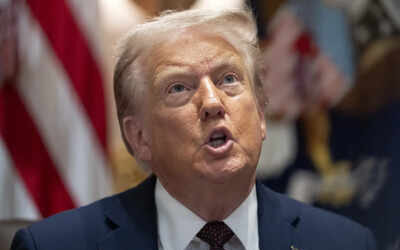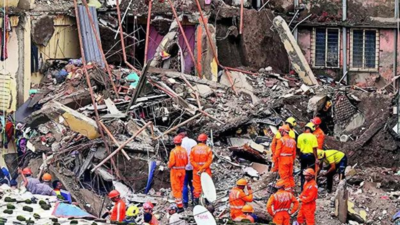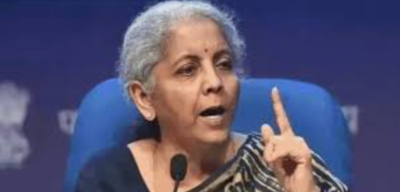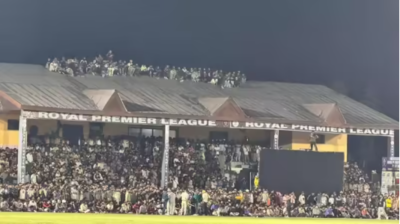‘Modi’s war’? Navarro targets India – How US, EU are ‘fuelling’ Russia-Ukraine conflict
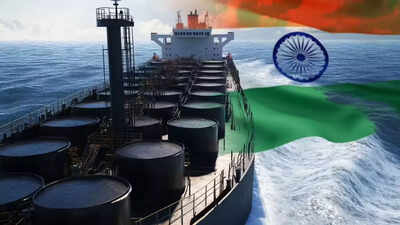
White House trade adviser Peter Navarro has sparked controversy by casting the Russia-Ukraine conflict as “Modi’s war.” In an interview with Bloomberg, Navarro argued that India’s purchases of discounted Russian oil are “fuelling Russia’s war machine” – and by extension forcing American taxpayers to bankroll the conflict. “Everybody in America loses because of what India is doing. The consumers and businesses and everything lose, and workers lose because India’s high tariffs cost us jobs, and factories, and income and higher wages. And then the taxpayers lose because we got to fund Modi’s war,” Navarro claimed.Navarro’s remarks come after Trump administration’s slapping of 50% tariffs on Indian goods, a punitive move for New Delhi’s continued energy trade with Moscow.Why it matters
- Navarro’s charge – effectively blaming India for prolonging Russia’s war in Ukraine – marks an unusually direct rift between Washington and New Delhi.
- It comes at a time when India, along with China, has emerged as one of the top buyers of Russian oil, taking advantage of steep war-time discounts. Navarro’s comments highlight growing Western frustration that India, despite being the world’s largest democracy, has not joined US-led sanctions on Russia.
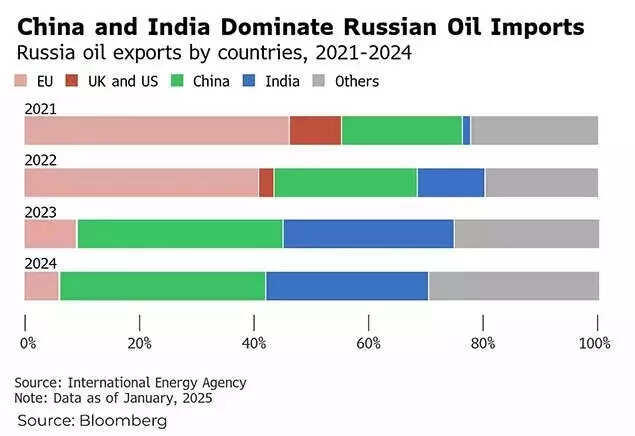
China and India dominate Russian oil imports
- However, this narrative, which attempts to pin responsibility on India, is a gross misrepresentation of the complex dynamics at play. The war in Ukraine is fundamentally a US and EU-driven endeavor, rooted in Nato’s expansionist policies, Western arms supplies, and economic entanglements with Russian energy resources.
- Critics say this narrative is also a distraction from Western culpability: by pinning the war’s continuation on India, it glosses over the US and Europe’s own roles in the conflict and their ongoing dealings with Russia. The duplicitous nature of the argument raises questions about whether blame is being shifted for political convenience, at the expense of a key partner like India.
Read more: ‘Trump won’t budge’ : US says Russia-Ukraine conflict is ‘Modi’s war’Between the linesWestern military involvement: Navarro’s portrayal omits the extensive role of the US and EU in the war’s trajectory. For years, Western powers have openly supported Ukraine’s Nato aspirations – a red line for Moscow. In 2008, Nato declared that Ukraine “will become a member” of the alliance, a pledge reiterated at the 2023 Vilnius summit that Ukraine’s “rightful place is in Nato” once conditions allow. Russia viewed these efforts as a direct threat, citing Nato’s eastward expansion as a key motive for its invasion.Once war broke out, Washington and European allies poured billions into weapons and aid to Kyiv. The US in particular has coordinated a “lend-lease” style pipeline: Eastern European countries send their Soviet-era tanks and jets to Ukraine, and the US backfills those stocks with modern arms. (For example, Slovakia supplied Ukraine with MiG-29 fighters and is receiving US F-16s in return). A new Nato funding mechanism, known as the Prioritized Ukraine Requirements List (PURL), has further reshaped the battlefield. Through this channel, the US has transferred $10 billion worth of weapons to Ukraine, with European allies footing the bill. The initiative compels Nato countries like the Netherlands, Denmark, Norway, and Sweden to purchase US-made systems such as Patriot missiles for Kyiv. The setup delivers dual benefits: shoring up Ukraine’s defenses while ensuring a steady stream of orders for American defense manufacturers, aligning both European security objectives and US economic interests.This proxy warfare has dramatically boosted US defense sales – American arms exports hit a record $319 billion in 2024 as allies raced to replenish weapons sent to Ukraine. According to a SIPRI report, Russia’s war has reshaped the global arms trade, cementing Washington’s dominance as the world’s top exporter. Shipments of American weapons to Europe increased by 233% during the 2020-2024 period compared with the previous five years, Europe became the largest destination for US arms, the SIPRI noted.By actively arming Ukraine and expanding Nato’s footprint, US and Western nations have undeniably influenced the war’s course – a context missing from Navarro’s “Modi’s war” narrative.Energy and economic hypocrisyNavarro’s focus on India’s oil trade also ignores ongoing US and EU commerce with Russia, even amid the war. Europe sharply reduced imports of Russian pipeline gas, yet it doubled down on LNG: in 2024, Russian liquefied natural gas deliveries to Europe hit record highs, making Russia the continent’s second-largest LNG supplier after the US. European buyers spent over €7 billion on Russian LNG last year, prompting charges of “glaring loopholes” in the sanctions.Data from the Centre for Research on Energy and Clean Air (Crea) found a 14% year-on-year rise in EU imports of Russian LNG came in 2024.
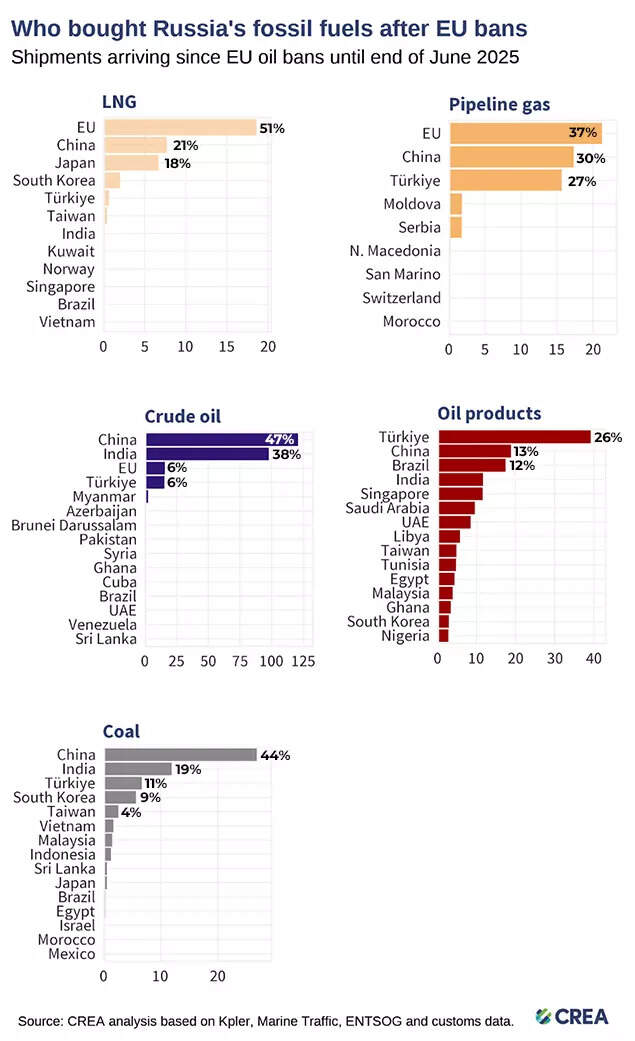
Who bought Russia’s fossil fuels after EU bans
“The reason for the rise is fairly simple,” Vaibhav Raghunandan, a Russia analyst at Crea, told the Guardian. “Russian LNG is offered at a discount to alternative suppliers … With no sanctions imposed on the commodity, companies are operating in their own self-interest and buying increasing quantities of gas from the cheapest supplier.”Meanwhile, the US continues to purchase Russian nuclear fuel for its power plants. In 2023, Russia was the largest foreign supplier of enriched uranium to the US, selling about $1.2 billion worth – a record volume not seen in a decade. (Although a ban on Russian uranium was passed to take full effect in 2028, special licenses have allowed these imports to persist.) This reliance means both Washington and Brussels are still injecting cash into Moscow’s coffers for critical energy commodities even as they sanction Russian oil and arms.Interestingly, there are no sanctions on China for buying Russian oil.
Navarro himself once implicitly conceded the US could not punish China because it had leverage. Trump has treated Putin with such reverence that he’s been called a Russian stooge by some US commentators, inviting the US President’s ire because he regards them as warmongers seeking constant strife, not peace, with Moscow.
Chidanand Rajghatta, The Times of India correspondent in US
Western officials themselves acknowledge the contradiction: “If they sell, it is because someone is buying,” EU foreign policy chief Josep Borrell acknowledged, noting that European refiners have been importing Indian diesel made from Russian crud. In short, while the West urges others to isolate Russia, it has not fully severed its own economic ties – underscoring the double standards in Navarro’s critique of India.
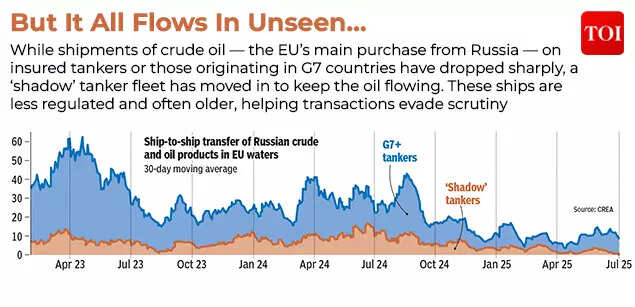
Shipments through ‘shadow’ tankers
The big pictureRussia’s war in Ukraine stands as Europe’s largest conflict since World War II – and it didn’t emerge in a vacuum. President Vladimir Putin launched the invasion in February 2022 to prevent what he saw as Ukraine drifting deeper into the Western orbit.Yet the war has ended up weakening Moscow while reinforcing Western unity. Nato has grown with Finland and Sweden joining its ranks, and member states are boosting defense budgets – moves that often channel contracts to US arms makers. At the same time, global energy flows have been sharply reshaped by the conflict.India, meanwhile, has navigated a cautious middle course. Prime Minister Narendra Modi has denounced the bloodshed and urged dialogue, but his government has stayed focused on national priorities – above all, ensuring affordable oil to power the country’s rapid economic growth.What they are saying
- Peter Navarro, Trump aide: “I mean Modi’s war because the road to peace runs, in part, through New Delhi… Russia uses the money [from oil] to fund its war machine… then Ukraine comes to us and Europe and says give us more money. So American taxpayers lose because we’ve got to fund Modi’s war.”
- S. Jaishankar, external affairs minister: “It’s funny to have people who work for a pro-business American administration accusing others of doing business… If you have a problem buying oil or refined products from India, don’t buy it. Europe buys, America buys, so if you don’t like it, don’t buy it.” He noted India’s Russian oil imports are a fraction of Europe’s and argued New Delhi’s purchases help stabilize global prices
- Lloyd Austin, US defense secretary: “We want to see Russia weakened to the degree that it can’t do the kinds of things that it has done in invading Ukraine.” This frank acknowledgment of US aims – made in April 2022 after a visit to Kyiv – signaled that beyond defending Ukraine, Washington’s strategy includes crippling Russia’s military for the long term.
What’s next
- In defiance of the US “sanctions”, Russian oil exports to India are expected to rise in September. According to a Reuters report, purchases of Russian oil by Indian refiners are set to increase by 10–20% in September over August levels—equivalent to an additional 150,000 to 300,000 barrels per day.
- PM Modi is heading to Japan and China to strengthen ties amid US tariff tensions.
- His Japan visit aims to boost “Make in India” via new investments and tech tie-ups.
- Modi’s China stop includes SCO summit and talks with both Chinese President Xi Jinping and Russian President Vladimir Putin.
(With inputs from agencies)
